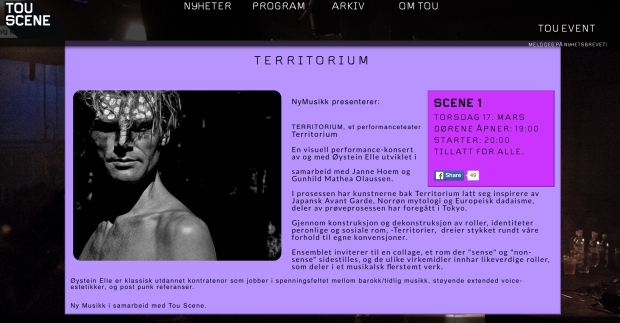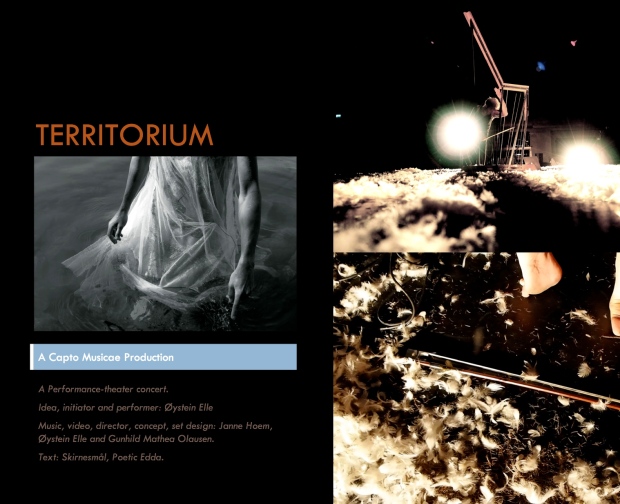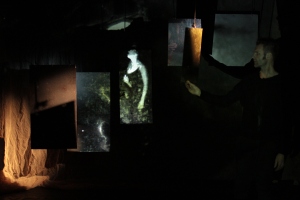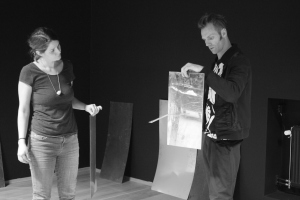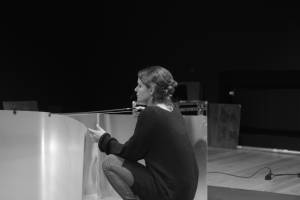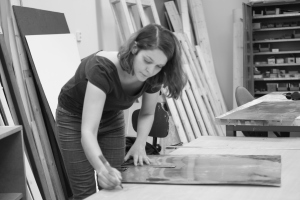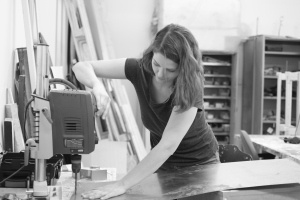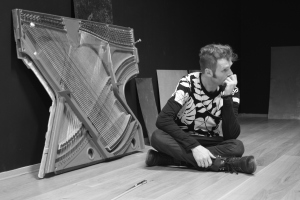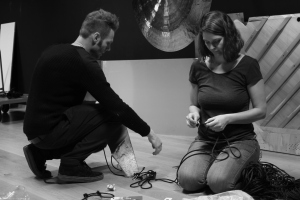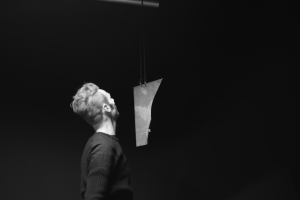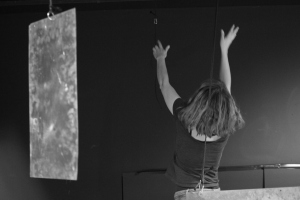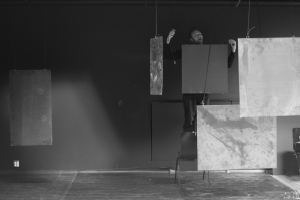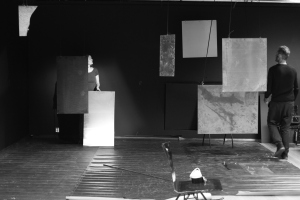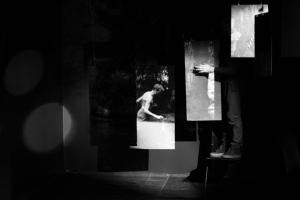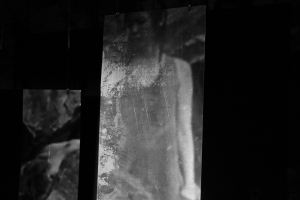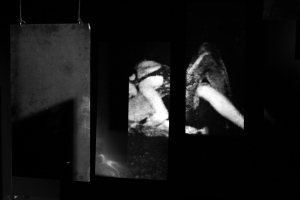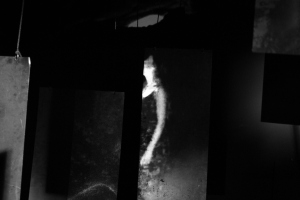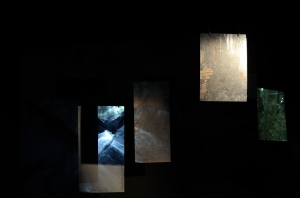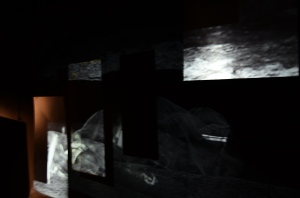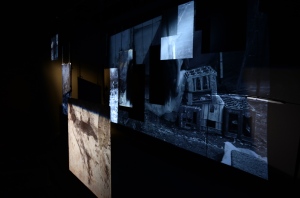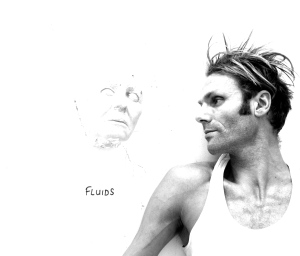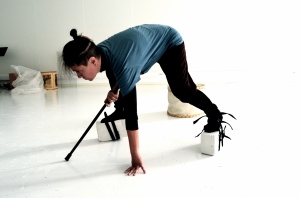An update on my main activities the last half year:
The music theatre production “Stuffed Camel – A Theatre Sonata” was premiered at Norwegian Theatre Academy October 15th, with further shows 16th and 17th.
Stuffed Camel is the largest stage production I include in the three year research project.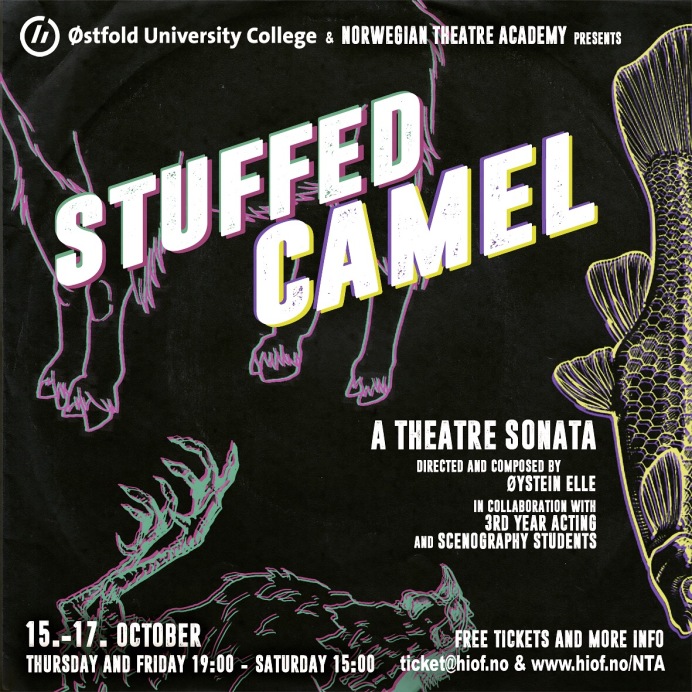
DIRECTOR/COMPOSER/CONCEPT/IDEA
Øystein Elle/Capto Musicae
DRAMATURG/CHOREOGRAPHER
Robert M. Johanson (Nature Theatre of Oklahoma)
ASSISTANT DIRECTOR
Anders Firing Aardal
SCENOGRAPHY/COSTUME/LIGHT
Johanna Dahlbäck
Jessica Tay
CO-CREATIVE PERFORMERS
Desiree Vaksdal
Jonas Borgensgaard
Katrine Nielsen
Nikoline Spjelkavik
Tobias Shaw Petersen
Marina Popovic
Victoria Røising
Anders Tougaard
Viola Tømte
SOUND ENGINEER
Ulf Knudsen
PRODUCTION COORDINATOR
Sunniva Solberg
CONCEPT DEVELOPING TEAM
Øystein Elle, Robert Johanson and Anders Firing Aardal
MUSIC
Øystein Elle
Except: “The Schreber song” By Robert Johanson
and Codetta melody by John Dowland (1563 – 1626)
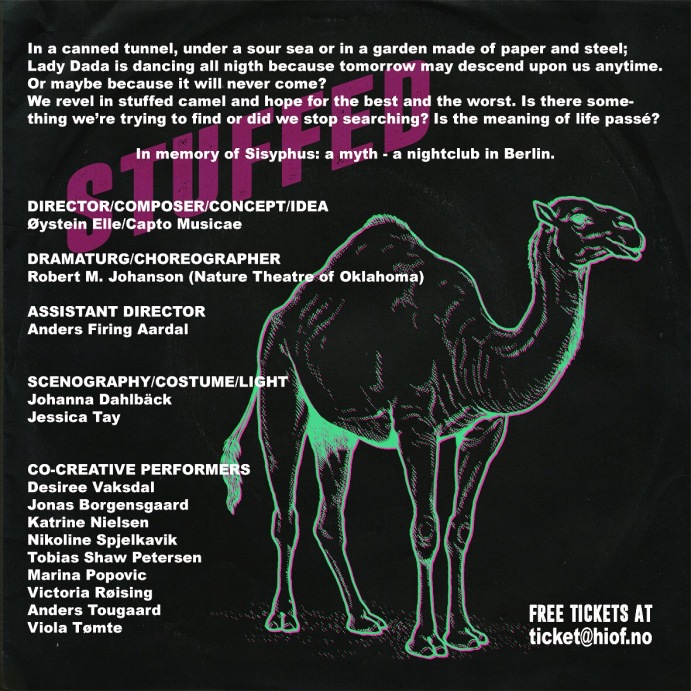
The play “Stuffed Camel – A Theatre Sonata” is a music theatre production developed especially for the third year acting students at the Norwegian Theatre Academy. Stuffed Camel is created within my research context, as part of my three year long project “Capto Musicae – Creating sonic and musical theatre in a contemporary artistic context” Through my research I am exploring and developing methods in which texts, sounds, visual and kinetic elements come together as equivalent elements. My work is historically grounded in baroque musical aesthetics, in twentieth century avant-garde aesthetics, and experimental approaches to the voice in performance, and in explorations of sound and voice within heavy rock, post punk and noise.
My research operates as a dialogue between music and theatre, and as such it both works with and responds to history in both fields. My methodology is cross-disciplinary, situated in theatre, moving equally between theatre and music. As a theatre maker I work through the eyes of a composer/performer/singer, where I let the voice, the space, the light, and the kinetic elements play their equivalent parts in a musical whole, as the parts in polyphone or homophone musical work. In this particular performance I am investigating the baroque-wiener classic musical form, Sonata as a vehicle for post-dramatic music theatre. “Stuffed Camel” is quite strictly composed after the principles of the Sonata. It consists of three movements A-B-A2 + Coda. The Exposition, the Development, the Resolution, and ending with a Coda. Each movement is put together following these over 200 years old musical rules. The manuscript is a compilation of texts from various sources, and also consists of reworks of the original texts. I aim to let the sound of the text and language be equated with the narrative content of it, and I always question the term “meaning” I believe that as extended voices, such as inhaled voices, or growls creates an added sonic value for the listener, a re-created or twisted text may do the same for the reader.
In this work the textual starting point is Albert Camus´ “The Myth of Sisyphus” where he introduces his philosophy of the absurd. ” Much of our life is built on the hope for tomorrow, yet tomorrow brings us closer to death, the ultimate enemy; people live as if they didn’t know about the certainty of death. Once stripped of its common romanticism, the world is a foreign, strange and inhuman place; true knowledge is impossible, and rationality and science cannot reveal the world—such explanations ultimately end in meaningless abstractions and metaphors. ” (Albert Camus)Øystein Elle, Director/Composer
I´ll post some better documentation as soon as get it.
Until then, here is some clips:

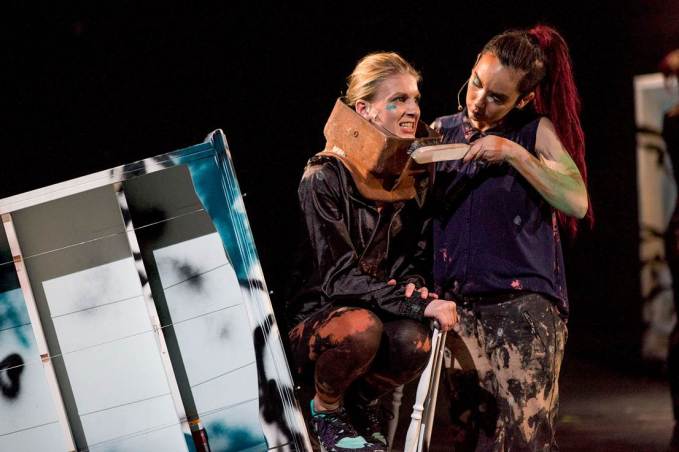
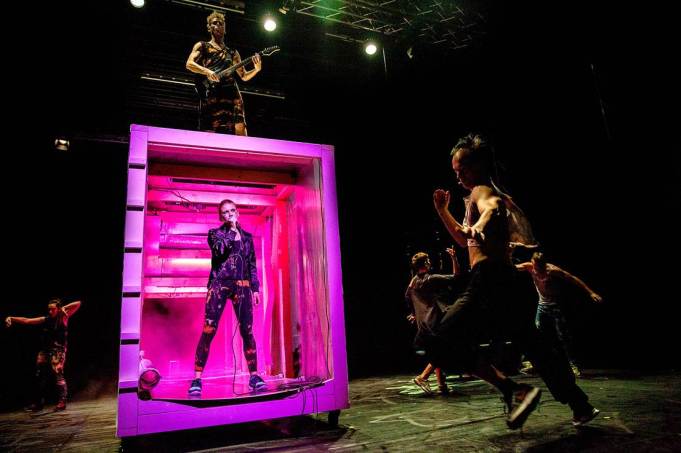



The Manuscript:
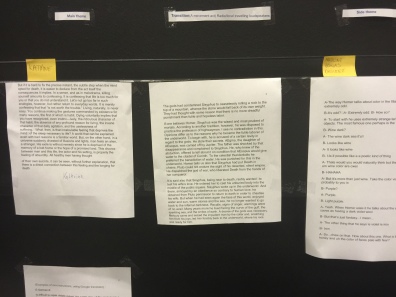
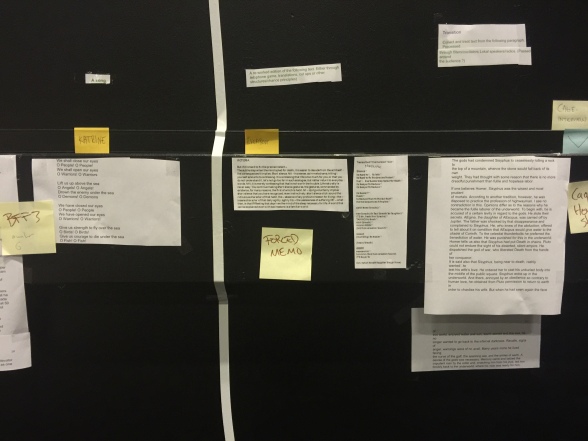
Testing sonic possibillities for violin and Cello as Noise-instruments
First days of Rehearsals:
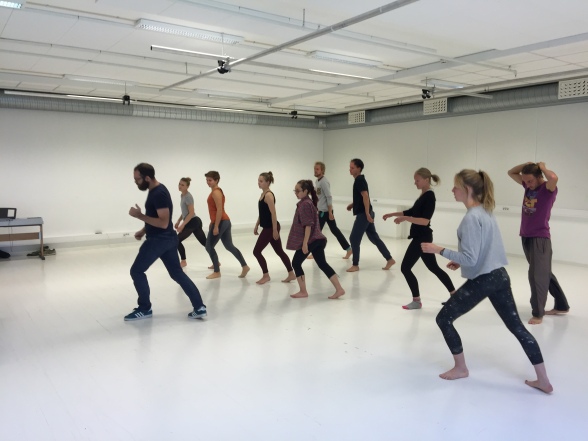
What´s in a name


The project Decadence & Decay had its third phase in April this year. Jill Sigman, Joro Boro, Corentin Leven and myself worked in Brooklyn New York towards a film shoot of the performance for a video edition. I have received support from Arts Council Norway to premiere Decadence & Decay in New York in 2016.
Working on the script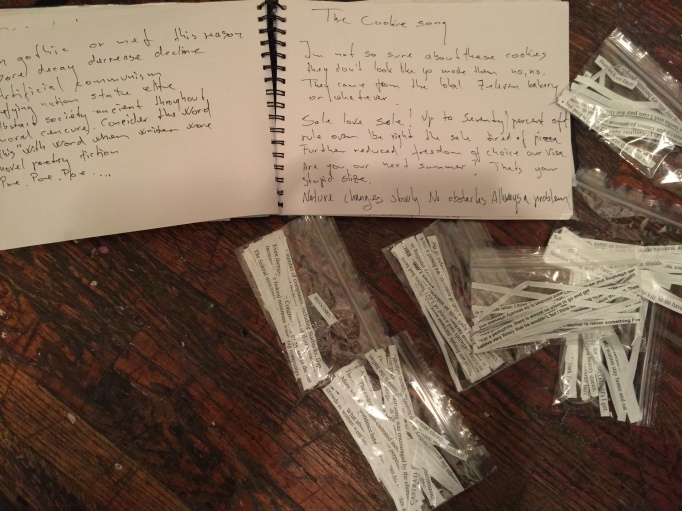
The video version of the piece is still to be edited, but here is some short excerpts.
Decadence & Decay Info
Territorium
Is a solo performance that I create in collaboration with 2nd year research Fellow scenographer and instrumentmaker Gunnhild Mathea Olausen, and with the visual artist and outside eye/director Janne Hoem. The footage that played when you cane in is film material connected to this projects process.
This piece is visually and litterary circling around an electric harp, custum made for this production by Gunnhild Mathea Olausen. The sound from it I manupulate live throuh noise devices, echo, and looping devices. Together with this I perform vocally, and investigate the connection between movement and extended voice performance. In the devellopment of this I work closely with Linda Wise, and through intenslive one to one workshop with the Butoh dance master Yoshito Ohno in Japan.

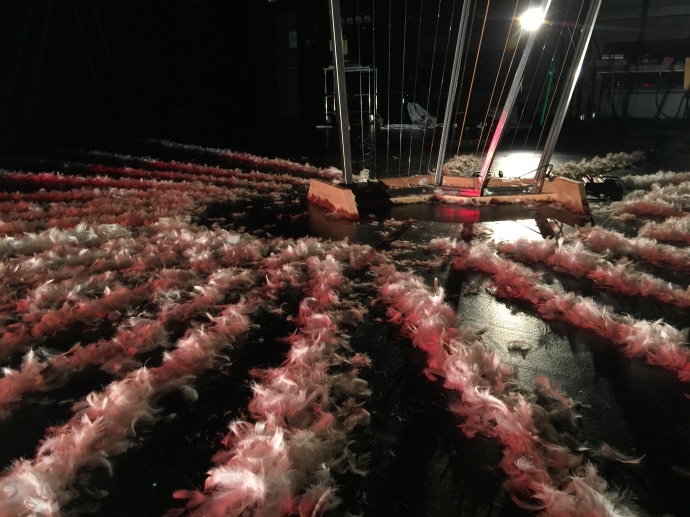
Together with research fellow Camilla Eeg-Tverbakk I arranged the research seminar Sounding Words at NTA. 8-9 May 2015.
Sounding Words
A two days research seminar on the relation between words, sounds/ musicality, and movement in contemporary performing arts practice.
In this seminar we are interested more specifically to research different working methodologies and approaches to treating text in performance, questioning traditional notions of interpretation and analysis, exploring text as musicality, sound and movement.
Questions:
– What are the connections and border areas between spoken word/ music/ sound/ movement?
– How can we practice words as music/ sound in performance, and what does this approach do to the interpretation of words and the audience reception?
– How to practice sounding words as movement/ composition/ choreography?
One approach to musically treating text is to write/ compose and rehearse the material, another is an improvisational approach. What skills are needed to accomplish these?
Program:
Day 1:
09.30 – 10.00 – coffee/ tea
10.00 – 11.30 – workshop/lecture Camilla Eeg-Tverbakk (N) and
Øystein Elle (N)
Relating to Things and Other Sounding Matters (Drawing Room)
11.30 – 12.30 – lecture/ demo Salomé Voegelin (UK)
Curatorial performance – singing lines of words (Dance Space)
12.30 – 13.30 – lunch (Drawing Room)
13.30 – 15.00 – workshop/ lecture Mette Edvardsen (N/B)
Three easy pieces & three not so easy pieces (Dance Space)
15.00 – 16.00 – demo/ workshop Sarah Ramin Osmundsen (N)
Tusen Solsikker / Thousand Sunflowers (Dance Space)
16.00 – 17.00 – discussions (Dance Space)
18.30 – Dinner
Day 2:
09.30 – 10.00 – coffee/ tea
10.00 – 11.00 – workshop/lecture Tore Vagn Lid (N)
DUB Leviathan” – (Reflexive) Etudes towards a scenic DUB (Drawing Room)
11.00 – 12.00 – lecture/ demo Electa Behrens (US/N)
Sounding Actions – suggestions for training the sonic border-crossing performer (Dance Space)
12.00 – 13.00 – lunch (Drawing Room)
13.00 – 14.00 – lecture Pieter Verstraete (NL)
Radical Connectivity through the Voice: A Socio-Aesthetic Re-Imagination
(Drawing Room)
14.00 – 16.00 – discussions with introduction (Drawing Room) by Linda Wise (F)
Bios
Electa Behrens is a voice pedagogue on the staff of the Norwegian Theatre Academy. She holds a Practice as Research PhD from Kent University (UK), an MA from Exeter University (UK) and a BA from Vassar College (USA). She has performed with many companies/artists throughout Europe and the USA including Odin Teatret (DK), Richard Schechner (USA), Marina Abramovic (Serbia), Dah Theatre (Serbia), F2 Performance Project (Greece), Saska Rakef (Slovenia), Robin Riegels (formerly of Workcenter of Jerzy Grotowski and Thomas Richards (NO), Instabili Vaganti (IT) and the Centre for Performance Research (Wales). As researcher and practitioner, she has participated in Paul Allain’s British Grotowski Network and Britain/Russia, an exchange with the Moscow Arts Theatre School as well as being part of 3 Giving Voice festivals organized by the CPR.
Contribution at Sounding Words: Working between the lines of text and song has been done for generations; it is older than it is new. However, with the artificial separations between sound/text/song which have solidified in the past 100 years, the contemporary performer needs strategies for how to refind their way back to a free-flow of vocal meaning across form. Another separation which has occurred, is that the task of composition has been delegated to “composers” and separated from those who will do. This has resulted in some trends within sound performance which are highly conceptual and ironically manage, even when working with the human voice one of the most undeniably vulnerable and “human” forms of communication, to distance the viewer/listener. This is unnecessary. My practical lecture takes as its topic performer training and how to integrate the embodied training of the performer’s voice with their vocal compositional skills. The primary proposal, is that for the performer to develop compositions which are not simply clever, they must begin from working with sound not as materials (songs/texts as building blocks of form) but rather to work out from an articulation of an ACTION – REACTION (naturalistic or not) in a HERE and NOW, towards form. This discussion will include practical examples to spark debate. Working in the spaces of slippage between sounds and meanings will be necessarily messy. Be prepared to make noise.
The work of Mette Edvardsen is situated within the performing arts field, also exploring other media or other formats such as video and books. She has worked for several years as a dancer and performer for Les Ballets C. de la B. with Hans Van den Broeck (1996-2000) and Christine de Smedt (2000-2005), and danced in pieces by Thomas Hauert/ ZOO (B), Bock/ Vincenzi (UK), Mårten Spångberg (S), Lynda Gaudreau (CAN), deepblue (N/B), and others. She created and produced two pieces in collaboration with Lilia Mestre (P/B), and the project Sauna in Exile in collaboration with Heine R. Avdal, Liv Hanne Haugen and Lawrence Malstaf in 2002/2004. She choreographed and danced a version of Thomas Lehmen’s Schreibstück together with Christine de Smedt and Mårten Spångberg in 2004. Her own work includes the pieces Private collection (2002), Time will show (detail) 2004, Opening (2005/ 2006), The way/ you move (installation, 2006), or else nobody will know (2007), every now and then (2009), Time has fallen asleep in the afternoon sunshine (2010), Black (2011), No Title (2014), We to be (2015) and the video works Stills (2002), coffee (2006), cigarette (2008) and Faits divers (2008). She presents her works internationally and continues to develop projects with other artists, both as a collaborator and as a performer.
http://www.metteedvardsen.be
www.manyone.be
Contribution at Sounding Words: In my last pieces I have worked extensively with language. The starting point did not arise from a question about language or speech, but in response to my previous works and more precisely my relation to objects. I think of choreography as ‘writing’, writing in time and space. I continue to explore the possibilities and limits of language, how reality exists in language and how this extends into real space. In my ‘writing’ I am interested in this friction between language and the physical world, between what is there and not there. Language has the power to make something appear by just naming it, but it is not enough to say that that something is gone in order to make it disappear again. Presence, imagination and memory are far more uncontrollable, ungraspable and unpredictable dimensions.
With the three pieces Black (2011), No Title (2014) and We to be (2015) I complete what I now regard as a trilogy. I will speak about these three works, and works that preceded them or accompanied them, as a way to propose how the pieces exist in a tension with each other. I think that ideas are not isolated but come out of a development and a process.
Camilla Eeg-Tverbakk is a Norwegian dramaturg, curator, teacher, and writer. She is currently working on a PhD at Roehampton University titled “Theatre – Ting, A Materialist Practice of Staging Documents”. She holds an MA in Performance Studies from New York University, and an MA in Theatre Science from the University of Oslo. Having been educated at Ècole Jacques Lecoq, Eeg-Tverbakk worked as a performer and theatre maker for many years in Norway. She was the administrative and artistic director of f.u.s.k – Forum for Exchange Between Performing Artists between 1997-99, programming international performing art in Oslo. She has also been involved in co-curating for the gallery Kunsthall Oslo and the site-specific project Artistic Interruptions in northern Norway. Between 2007 – 2011 Eeg-Tverbakk held the position as Artistic Director of the Acting Program at the Norwegian Theatre Academy / Østfold University College, where she still teaches. Eeg-Tverbakk was the editor of the books Dans i Samtiden (Spartacus 2006) and Performance Art by Baktruppen, First Part (Kontur 2009). She has worked as a dramaturg for dance, theatre and opera, and has co-curated for festivals and programs of theatre, dance, performance art and site-specific art.
Contribution at Sounding Words: I will speak about my current research focussing on ways of performing documentary text. This has led me to experimenting with a rhythmic rather than analytic and psychological way of relating to text in performance. I will argue for the reasons and possible outcomes of this approach, which relates to Object Oriented Ontology, as well as referencing two French philosophers; Jean-Luc Nancy and Henry Lefebvre. My talk will offer some practical try-outs in collaboration with Øystein Elle where words, sound, objects and movement are composed into rhythmic relations.
Øystein Elle is a singer, performer and composer currently employed as an artistic research fellow at Norwegian Theatre Academy, Østfold University College.
Earlier he held a position as an assistant professor at the same institution, teaching in the field of voice, singing and improvisation/composition. He studied singing (baritone and countertenor) composition, conducting and piano at the Music Academy in Utrecht, the Netherlands (MA) and at the Conservatory of Music at Agder University (BA). He is active as a creating, and a performing artist with a number of independent groups and theatre institutions, as well as developing his own interdisciplinary works. As both a composer and as a performer he has been presented at festivals and venues in a number of countries in, and outside Europa. As a singer he is specialized in the field of Baroque music, and is often mixing aesthetics from this field in to experimental and contemporary music, including noise, and free improvisation. He has also premiered a number of compositions by Norwegian and foreign composers, written especially for his countertenor voice.
Contribution at Sounding Words: I will show, try out, and talk about examples of aural textual sequences. In my on-going artistic research project “Capto Musicae – creating sonic and musical theatre in a contemporary artistic context” I am experimenting with meaning as well as with voice timbres and vocal aesthetics, in different forms of interpretation, and (re-) creation of text. I am approaching the textual material as a music-composer, seeing the signs, letters, words, and sentences as sonic building blocks, challenging the semiotic boundaries. Where is the border between interpretation – improvisation and between re-construction and transformation?
Sarah Ramin Osmundsen is a spoken word poet, singer and story-teller. She lives and works in Oslo, with roots from Norway and Martinique. She has experience as an actor and playwright at amongst other places The House of Drama in Oslo (Dramatikkens Hus), Text Lab, Oslo Nye Teater, and Det Norske Teateret. Sarah expresses her Caribbean art form through various performances, including poetry, language, stories and music. In 2011, she won the Norwegian National award for best slam poet, during spring 2013 she collaborated with
Tore Vagn Lid is a stage director, playwright and composer. He is the artistic leader for the theatre ensemble Transiteatret-Bergen, and has a PhD from the Institut für angewandte Theaterwissenschaft, Giessen (Germany). He also holds a professorship at the National Academy of Arts (Oslo) and is the director of the Artistic Reseach Program Knowledge & skills for the post dramatic theatre. Working both with his theatre ensemble Transiteatret-Bergen and with other scenic projects, Lid has received several prices for his works. Among them are the prestigious National Critics Award 2013 for his own play “Kill them all! – game of sorrow#2”, the National Hedda-price (both 2008 and 2009), “The National Broadcasting Award “Blue Bird” and the Scandinavian Award for the best Radio play of the year 2012. Lid was also the first Norwegian director to be invited to the program “Young Directors Project” at the Salzburg Festiva in Austria, 2008. Lid has published and edited several works on topics such as dramaturgy/music-dramaturgy, aesthetics, acting and directing. His book “Gegenseitige Verfremdungen – Theater als kritischer Erfahrungsraum im Stoffwechsel zwischen Bühne und Musik” was published at Peter Lang Verlag, 2011.
Contribution at Sounding Words: The “DUB Leviathan!” project is an ongoing experiment exploring the possibilities and potential of what I have called Scenic Dub. During the Bergen International Festival in May, “DUB Leviathan! will be performed as a staged album consisting of three different records, played in different combinations. This discussion/demonstration takes this artistic research process as its point of departure, highlighting Scenic DUB as a metabolism of music in theatre and theatre in music.
Pieter Verstraete is a theatre scholar, a cultural critic and a researcher based in Turkey. He is currently a Lecturer at the American Culture and Literature Department of Hacettepe University in Ankara. Since 2012, he has held an Honorary University Fellowship of the University of Exeter. Previously, he has also been teaching at the Radboud University Nijmegen, the University of Exeter, Istanbul Bilgi University, Bilkent University Ankara and Atilim University Ankara. In 2009, Verstraete completed his PhD, entitled The Frequency of Imagination: Auditory Distress and Aurality in Contemporary Music Theatre, at the University of Amsterdam, School for Cultural Analysis. He has co-edited and authored numerous works on sound, vocal art, interactive installation art, aurality and audio culture in Performing the Matrix (Epodium 2008), Sonic Mediations (CSP 2008), Performance Research (Routledge 2010), Theatre Noise (CSP 2012), and The Legacy of Opera (Rodopi 2013). He is a co-editor of Cathy Berberian: Pioneer of Contemporary Vocality (Ashgate 2014) as well as Inside Knowledge (CSP 2009). His research on Turkish post-migrant opera was granted the support of a Tübitak Fellowship for Foreign Citizens at Ankara University, a Mercator-IPC Fellowship at the Istanbul Policy Center of Sabancı University Istanbul and a Türkiye Burslari Research scholarship at the Migration Research Center of Istanbul Bilgi University. Verstraete has also been writing and lecturing on new urban forms of theatre, post-migration in performance, cultural policy, social protest and theatre activism in Turkey.
Contribution at Sounding Words: Against the backdrop of what I would like to call ‘radical vocality’ as a notion to reconsider vocal art history, I will focus on the social and aesthetic implications of extended techniques – including body movements – in vocal performance art. Starting from the disposition of the human singing voice – if we can conceive such a thing – and its extensions as well as its distortions by means of technology, I will discuss a conceptual framework that re-attaches the aesthetic implications of the phonographic practice, such as it developed through ‘schizophonia’ and interactivity, to the social realm of experience in terms of vocal space, vocalic body, activism of voice, the listener’s attention, acoustic community and finally, aurality. My contribution will bring together some of my latest research on interactive music, locative media and other new forms of connectivity in an attempt to conceptualize and analyze a rehabilitated sense of ‘community’ through the experience of voice in the digital age.
Salomé Voegelin is a Swiss artist and writer based in London. She is the author of Listening to Noise and Silence: Towards a Philosophy of Sound Art, Continuum, NY, 2010, and Sonic Possible Worlds: Hearing the Continuum of Sound, Bloomsbury, NY 2014.
Her artistic practice involves sound and text works produced in collaboration with David Mollin as well as a solo compositional practice. While her solo work focuses on the small and slight, unseen performances and moments that almost fail to happen, her collaborative work has a more conceptual basis, establishing through words and sounds conversations and reconfigurations of relationships and realities. A recent text-sound work by Voegelin and Mollin was shown at Lydgalleriet in Bergen, Norway in November and December 2014. Voegelin is Reader in Sound Arts at the London College of Communication, University of the Arts London.
www.salomevoegelin.net/ www.soundwords.tumblr.com
Contribution at Sounding Words: I will read, talk and recite texts, and play, sing and shout sonic works to produce non-hierarchical interactions between sonic, musical and textual words. In this way the performance of words as sound, as voice and body, is enacted in the same timespace as the performance of their theorisation. The distinction between the two is thus put into doubt in terms of form as well as content, prompting questions which foreground the politics of their initial separation: the politics of the transparency of words as text, as meaning and signification; and the politics of the ambiguity of words as sound, as invisible poetics. What is sought is a phonography of the voice and of words, of the tongue and of lines that puts into critical contemplation a politics of wording.
These performance based contemplations might give rise to a sonic-semiotics between lied and line, between song and bark; they might equally spark a discussion of disciplinary boundaries and the government of meaning, identity and sense within the frame of language and music, as opposed to the expectation of nonsense and process based subjectivities elsewhere in sound.
Linda Wise is an actress, theatre director and voice teacher. Born in Kenya and trained at the Royal Scottish Academy of Music and Drama. She worked with Roy Hart from 1969 until his death in 1975. Member of the original Roy Hart Theatre and founder member of the Roy Hart Centre in the South of France. Linda is invited to direct, teach and act throughout the world. She won the 1988 French Jean Vilar Prize for her direction of Melville’s “Moby Dick”, and performed Nedda in the OBIE award winning adaptation of Leoncavallo’s “Pagliacci”. Passionately concerned with a vision of the voice that engages the widest possible perspective on each person’s individuality, she incorporates into her practice a range of vocal approaches, from Roy Hart’s extended range techniques, to bel canto, to Feldenkrais. She has taught voice in the National Theatre Schools of Copenhagen, Norway, Australia, New Zealand, Argentina and Scotland and is a visiting teacher at the Limoges and Strasbourg French National Theatre Schools. She collaborates with an international circle of artists and thinkers in the field of therapy, archetypal psychology and mythology.
Participants after a performance lecture by Selome Voegelin 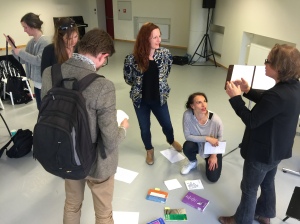
 Mette Edvardsen giving a performance lecture.
Mette Edvardsen giving a performance lecture.
In addition to the activities described above,
- I have been teaching a two week workshop at Norwegian Theatre Academy together with Birgitte Fjeld Bjørsvik. A practical workshop on extended voice work and movement.
- I have participated in a on week long Deep listening retreat with Pauline Oliveros, Heloise Gold and Ione, in Vesterålen, Norway.
- I have had three days of intensive sessions with Linda Wise, working on extended voice techniques for the solo performance Territorium.
- I have presented my work at The Artistic Research Forum in Kristiansand, with emphasis on my methods and methodology within my artistic research.

